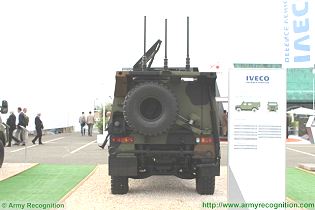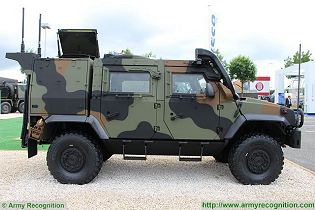| Armament |
|
The new hardtop “dual-role”, made of a ballistic steel monocoque framework with lightweight aluminum/steel roll-bar, allows the vehicle to be equipped either with a manual weapon turret armed with machine gun up to 12.7mm caliber or one automatic grenade launcher. In option, the LMV 2 can be fitted with a Remote Weapon Station (RWS),
|
| Design and protection |
The layout of the LMV 2 is similar to the previous version of the LMV. There is two seats at the front and two seats at the rear. The roof of the vehicle rests on a high resistant roll-bar. There is two doors on each side of the vehicle with sliding and dismountable windows. The front of the crew compartment is fitted with a large windscreen and this is provided with three two-speed wipers and washers. On the roof is a hatch suitable for a central positioned weapon ring. The new crew cell design has been developed particularly by the need to accommodate five fully-equipped soldiers, including body armour and personal equipment. Most internal roll-bars have been redesigned, enhancing the available legroom, while the internal cab height is 100 mm greater than on the standard LMV, thus enhancing internal space and habitability. The internal layout of the new crew cell improves crew ergonomics, as well as incorporating a next-generation digitised dashboard and an upgraded hardtop. IED protection is further enhanced by the addition of a third hinge added to each door and the use of new materials.
|
| Mobility |
|
The LMV 2 is motorized with a new 220 horsepower engine, presents an upgraded driveline capable of managing more power, and a new air filtration system. In order to provide maximum mobility, a new automatic gearbox, upgraded with two additional speeds (eight in total), makes the transition between gears smoother when driving off-road. When operated in conjunction with the automatic drive management system (ADM), this ensures that the vehicle performance is optimized to meet the challenges of the most demanding of terrain scenarios. The LMV 2 can run at a maximum road speed of 110 km/h with a maximum cruising range of 600 km. The LMV II can negotiate side slopes of 30% and fording depth of 1.5 m without preparation.
|
| Accessories |
|
A new electronic stability control (ESP) system, able to work in off road conditions, enhances driving safety as well as driver comfort and agility. There is one spare wheeld mounted at the rear of the vehicle. LMV2 is designed to accommodate extensive GFE, including radios, BMS (Battle Management System), intercom and Electronic Counter Measures (ECM). The vehicle is extremely well adaptable to being deployed as a mobile radio platform, by the nature of its outstanding Electromagnetic Compatibility (EMC) profile and can fulfill the most demanding DEF-STAN and MIL-STD requirements. Sub-system integration has also been greatly eased by the adoption of a new vehicle digitised electronic architecture and an improved power supply. This allows for mission systems such as remote controlled weapon stations, BMS, intercom, and ECM to be seamlessly integrated onto the platform without complication. The new digitised dashboard provides on demand maintenance based data on prognostics, allowing the user to accurately review and schedule maintenance tasks, instead of predicting and scheduling preventive maintenance. A self-recovery winch is mounted at the front of the vehicle.
|
| |
| Specifications |
| Back to top |
|
Armament
|
|
One machine gun up to 12.7mm caliber or automatic grenade launcher
|
|
Country users
|
|
Prototype
|
|
Designer Country
|
|
Italy
|
|
Accessories
|
|
GFE, including radios, BMS (Battle Management System), intercom and Electronic Counter Measures
(ECM).
|
|
Crew
|
|
5
|
|
|
Armor
|
|
STANAG 4569 Level 1 and 2
a
|
|
Weight
|
|
8,100 kg
|
|
Speed
|
|
110 km/h and 65 km/h all-terrain
|
|
Range
|
|
600 km
a
a
|
|
Dimensions
|
|
Length: 3.23 m; Width: 2.05 m; Height: 2.17 m
|
|
|
|
| |
|

































